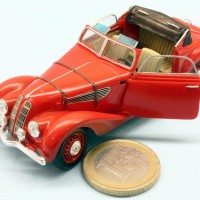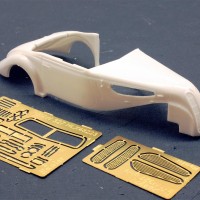A photo and its consequences: BMW 327 Touring Car
I will begin my words on this remarkable piece of automobile history with a confession: I am not an automobile connoisseur! I am also unfamiliar with the enthusiasm that arises in many car enthusiasts at the mere mention of the BMW car brand. But that doesn't have to be a disadvantage when it comes to building a BMW model: with an innocent eye, so to speak, a few insights open up that may bring a tired smile to the hardened car freak, but astonish me, the newcomer. There was a lot for me to marvel at, as I will explain in a moment.
BMW 327 Tourenwagen
The BMW 327, manufactured in various versions at the BMW plant in Eisenach from 1937 to 1941, positioned itself in the absolute upper class of vehicle construction at the time. In terms of speed, driving comfort, luxurious equipment and modern design - as well as price - the sleek design had outstripped any competition. Surprising for me was the result, if you compare these claims with the technical data!
Who would have thought that a car with 50 hp and a top speed of 125 km/h (with a high-powered 80 hp engine up to 150 km/h) would be at the top of the range?
The power output of 50 hp, which is meagre from today's point of view, was obtained from a displacement of 1971 cm3. If the compression ratio was increased from 1:6 to 1:6.3, a little more power could be obtained from the 6-cylinder in-line engine with 55 hp. A gearbox mounted between the engine and the cardan shaft offered the driver four gears and a reverse gear. However, only the third and fourth gears were synchronised, so the famous "intermediate throttle" was still necessary in this luxury car.
The driver was also challenged on longer journeys: a foot pedal had to be depressed several times every 50 kilometres in wet conditions and every 30 kilometres in dry conditions: even in a luxury car like this, the lubrication of the wheel-axle joints was done in a way that seems somewhat shirt-sleeved to today's drivers.
Even beyond these peculiarities, the BMW 327 is interesting: technically and formally, it represents an epochal boundary. For one thing, an upmarket automobile was not yet a mass-produced item at the end of the 1930s. The production of the BMW 327 was not yet carried out on an assembly line: all parts of the car were individually handcrafted or customised. In this elaborate way, 1606 "Kabriolett", as this body variant was still called at the time, and 265 BMW 327 Coupes were produced by the end of production.
During the four years of production, the price of these handcrafted gems amounted to 7450 Reichsmarks for the Coupe variant, and even a little more for the BMW 327 "Kabriolett" at 7500 Reichsmarks. As difficult as these sums are to convert to today's purchasing power, one thing is certain: a BMW 327 was only accessible to the truly wealthy.
The forms of this impressive "touring car" are a clear sign of modernity: while in previous designs the wings and headlights often stood out as separate, individual elements from the body panelling, the BMW 327 shows these forms aerodynamically and aesthetically integrated into the shape of the body. The deliberate staging of speed and power as well as the intended formal proximity to contemporary aircraft construction are clearly visible in this design. Under the skin, too, the BMW 327 shows itself to be "state of the art" and trend-setting: the use of new sheet metal bending processes and advances in welding technology - here, too, there are cross-references to the all-metal aircraft construction of the time - made it possible to realise the design with its aerodynamically elegant lines.
One last point, which I also found quite remarkable, should be put here at the end. The end of BMW production in 1941 did not mean the end of the 327. After the war, production of this luxury car continued undaunted at the old Eisenach site between 1952 and 55. In the meantime, however, the Eisenach production site was located in the Soviet zone, and after legal disputes with BMW, the site producing in the Soviet zone had to call itself "Eisenacher Motorenwerke EMW" - and the approximately 500 newly produced 327s bore the prefix "EMW".
After the British post-war industry also converted to a peacetime economy, the history of the BMW 327 was even enriched by a chapter with left-hand drive: the Bristol Aircraft Company founded "Bristol Cars", a branch that took on vehicle production. In their search for worthwhile designs, they came across the BMW 327 and built a not inconsiderable number of them as the "Bristol 400" from 1947 onwards. This is also significant because the "400" in turn was to provide the basic structure for subsequent Bristol Cars models such as the Bristol 406 or the Bristol Blenheim - again a strong reference to aviation!
In mid-1943, fighter ace Josef Priller was positioned and photographed in front of his Fw 190A-5 "Black 13" at Lille-Vendeville airbase. The special thing about it is that he appears to be getting into or out of a BMW 327/55 sports car. What at first glance could be mistaken for a pure propaganda shot turns out to be an advertising shot arranged by BMW. Whether propaganda or advertising coup: the associative power of this shot seems to have been great enough to secure the image respectable notoriety.
This notoriety, in turn, led Hasegawa to release a separate edition of their excellent Fw 190A-5 kit in 2007, dedicated to this picture, with a model of a BMW 327 and a figure of Josef Priller: with the contents of this kit, one could recreate the scenery of the 1943 photograph, The model of a BMW 327 shown here is from this kit.
About the building process
In the kit parts I found the qualities of Hasegawa's Fw 190 again: comfortable fitting accuracy, convincing, though not exaggerated, abundance of detail and a solid parts build-up, which can lead to a solid result relatively quickly and without complications. Since the manufacturer "Hauler" offers an attractive etched parts set for Hasegawa's BMW 327, this was obtained and installed. So the solid cast radiator grills are sawn out and replaced with those made of metal, a few more metal parts from the set further detail the model.
A risk for me was the choice of the paint: for these cars a high gloss finish is obligatory. Gunze's "Shine Red" also looks good in this role; here I didn't even use clear varnish but applied several layers of pure and unsealed varnish.
The BMW 327 also amazed me for a last time- as a model! I could hardly believe how small it looked next to the Fw 190!
This excursion has certainly not made me a car connoisseur and the sound of the word "BMW" still leaves me cold, but one thing has certainly been deepened: respect for car modellers who know how to give their marvels convincing and, above all, flawless glossy paint finishes. This powerfully elegant touring car gave me an inkling of just how challenging that must be!




















Great build and fun reading the history!
Thanks for the inspiration, Roland. I just also built the airplane model in this kit (after it sat in the stash for 15 years!) and have the car model that I wasn't sure I would do - but you have convinced me otherwise.
Beautiful result, Roland @rosachsenhofer
Equally for the article, very informative and a pleasure to read.
Fantastic build and article, Roland! It was really great to read the rich history of the type, while admiring your model!
Nicely done Roland, outstanding article as well.
Again, I am entertained and educated by another excellent Roland Sachsenhofer article. Thanks Roland @rosachsenhofer! ?
Looks great!
Great work, Roland. Nice to see that built.
Late, but all the more heartfelt, I would like to thank you for your comments and motivating feedback - your appreciated interest is a real incentive and pleasure for me!